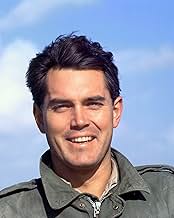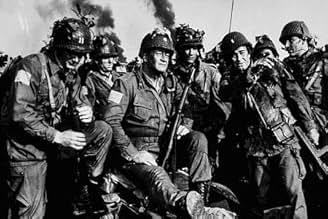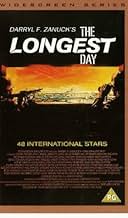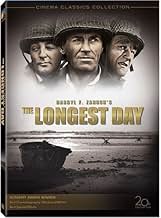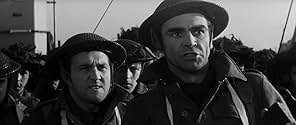डी-डे की घटनाओं को मित्र देशों और जर्मन दोनों दृष्टिकोणों से भव्य पैमाने पर बताया गया है।डी-डे की घटनाओं को मित्र देशों और जर्मन दोनों दृष्टिकोणों से भव्य पैमाने पर बताया गया है।डी-डे की घटनाओं को मित्र देशों और जर्मन दोनों दृष्टिकोणों से भव्य पैमाने पर बताया गया है।
- 2 ऑस्कर जीते
- 8 जीत और कुल 6 नामांकन
Irina Demick
- Janine Boitard
- (as Irina Demich)
फ़ीचर्ड समीक्षाएं
The Longest Day works on several levels - the most obvious being the "don't blink or you might miss several" nature of the Star-Studded cast. Much of the cast works very well (Sean Connery's little comedy double act with Norman Rossington is an unexpected highlight). Some less so, and some is just downright tokenism - Rod Steiger getting all of 43 seconds on-screen for example. But overall, it's always a watchable movie - beautifully shot.
Some previous comment have surprised me, particularly the assertion that The Longest Day is, in any way, a "pro-war" film. I'm not sure if there *is* such a thing, but if there is then The LOngest Day certainly doesn't fall into this category - the scene of bewilderment between Richard Burton and Richard Beymer at the end about the confusion and directionlessness of war is the perfect example, ending with the memorable line "I wonder who won".
I'm also surprised that a European reviewer should have accused this film, of all world war II movies, of being American propoganda. I wonder how many other WWII films include both German and (almost unqiuely) French perspectives of the war to such an extent that almost half of the dialogue in them is in a language other than English. I find the German sequences in The Longest Day to be amongst the most interesting historically and dramatically.
The film is certainly as accurate as it's possible for a fictional movie to be - the list of advisors that it had working on it should prove that - including many people who are portrayed by actors in the movie itself. These include the characters played by Peter Lawford, Richard Todd and Kenneth More, along with several of the German field officers. Little touches that seem utterly out of place (like the nuns procession through the French village bringing a temporary ceasefire) are actually historically spot-on.
The final problem for the modern reviewer, of course, is the inevitable comparison between this film and Saving Private Ryan. But, as several other contributors have noted, SPR is not only the product of a different age with a different view of these events - historical as opposed to something which happened so recently that half of the audience are likely to have lived through them. But, ultimately, something usually forgotten about Operation Overlord is that Omaha Beach was merely one battle of a very long day indeed. Americans tend to focus on it because of the death toll, but the taking of Utah, Sword and Gold were just as important to the overall outcome. The Longest Day is a film about five beaches, many battles, and many men - some, as Richard Burton says, dead, some crippled and some lost. It is an anti-war film which proves that you can be anti-war and still celebrate and acknowledge heorism. The heroism of the young American and British troops, falling face-first into the salt water of the Normandy killing grounds. The incredible bravery of the Rangers who scaled the cliffs at Pointe du Luc on and, ultimately, meaningless mission. The heroism of the two Luftwaffe pilots commanded to face the invading armies alone, and who did so (another historically accurate point).
The Longest Day is a historic film about a historical event and it should be viewed as such.
9/10
Some previous comment have surprised me, particularly the assertion that The Longest Day is, in any way, a "pro-war" film. I'm not sure if there *is* such a thing, but if there is then The LOngest Day certainly doesn't fall into this category - the scene of bewilderment between Richard Burton and Richard Beymer at the end about the confusion and directionlessness of war is the perfect example, ending with the memorable line "I wonder who won".
I'm also surprised that a European reviewer should have accused this film, of all world war II movies, of being American propoganda. I wonder how many other WWII films include both German and (almost unqiuely) French perspectives of the war to such an extent that almost half of the dialogue in them is in a language other than English. I find the German sequences in The Longest Day to be amongst the most interesting historically and dramatically.
The film is certainly as accurate as it's possible for a fictional movie to be - the list of advisors that it had working on it should prove that - including many people who are portrayed by actors in the movie itself. These include the characters played by Peter Lawford, Richard Todd and Kenneth More, along with several of the German field officers. Little touches that seem utterly out of place (like the nuns procession through the French village bringing a temporary ceasefire) are actually historically spot-on.
The final problem for the modern reviewer, of course, is the inevitable comparison between this film and Saving Private Ryan. But, as several other contributors have noted, SPR is not only the product of a different age with a different view of these events - historical as opposed to something which happened so recently that half of the audience are likely to have lived through them. But, ultimately, something usually forgotten about Operation Overlord is that Omaha Beach was merely one battle of a very long day indeed. Americans tend to focus on it because of the death toll, but the taking of Utah, Sword and Gold were just as important to the overall outcome. The Longest Day is a film about five beaches, many battles, and many men - some, as Richard Burton says, dead, some crippled and some lost. It is an anti-war film which proves that you can be anti-war and still celebrate and acknowledge heorism. The heroism of the young American and British troops, falling face-first into the salt water of the Normandy killing grounds. The incredible bravery of the Rangers who scaled the cliffs at Pointe du Luc on and, ultimately, meaningless mission. The heroism of the two Luftwaffe pilots commanded to face the invading armies alone, and who did so (another historically accurate point).
The Longest Day is a historic film about a historical event and it should be viewed as such.
9/10
This an important, interesting movie depicting the Overlord operation with monumental logistic and means of effecting the Normandy landing , the most difficult campaign of war . The picture brings to life the famous images of WWII and splendidly the most sensational military operation of the history in an Allied hard-fought effort . The film develops the previous days to the D-Day invasion , such as the landings and the advance over France . The film is magnificently produced in big budget by the great 20th Century Fox producer Darryl F. Zanuck . Evocative cinematography by Jean Bourgoun and catching song by Paul Anka with musical score by Maurice Jarre . Excellent casting by a great plethora of stars . Special mention for John Wayne as Lt. Colonel Benjamin Vandervoort , he's top-notch as a tough , valiant officer in this believable war film and terrific acting by Richard Todd as Major commanding Us paratroopers dropped to protect the flanks of the invasion and taking strategic bridge . Furthermore , known Generals and officers played by prestigious players , as Germans : General Gunther (Curt Jurgens) , Field Marshal Erwin Rommel (Hinz) , Field Marshal Von Rundstedt (Paul Hartmann), and Allied : Brig. General Theodore Roosevelt Jr (Henry Fonda) , Brig. General Norman Cota (Robert Mitchum) , General Haines (Mel Ferrer) , Brig. General James Gavin (Robert Ryan) , General Raymond Barton (Edmond O'Brien), Lt General OMar N Bradley (Stuart) , General Bernard L Montgomery (T. Reid) and General Dwight D. Eisenhower played by Henry Grace . Grace was a famed set designer , while he worked extensively for many films , his only appearance was an uncredited performance as Eisenhower ; despite not being an actor , he was cast for his uncanny resemblance to the General . This famous event from how was orchestrated the dangerous , risky landing maneuvers was professionally directed by a magnificent trio of directors , Ken Annakin , Bernhard Wicki and Andrew Marton.
Adding more details along with the well developed on the movie , the events that happened on June 6, 1944 were the following ones : Shortly after midnight on June 6, about 23.500 US and British paratroopers landed along the edges of the landing beaches . Their mission was to seize vital bridges and communications centers. They also had to hold off any Germans counterattacks until they were relieved by the amphibious forces. The Airbone landings were largely successful. Some US troops missed their target and end up scattered over the countryside. The main amphibious landings took place after an artillery bombardment from some 200 Allied warships at German positions also came under attack from Allied medium and heavy bombers. They were part of the 11,500 aircraft committed to D-Day. They bombed the Germans on and behind the five landing beaches. US troops landed on Utah beach. Strong currents and inaccurate navigation meant that they were a little away from their precise target. They landed about 1 mile (1,6 km) south. The beach there was relatively undefended. The troops soon knocked out the only concrete gun position guarding the beach.Demolitions teams cleared paths through the obstacles the beach and the first tanks crossed the Atlantic Wall. They fanned out into the countryside to link up with the paratroopers. By nightfall of D-Day some 23,000 men and 1,700 vehicles had gone ashore. The beach had been highly congested for much of the day. Utah was a triumph ,however Omaha beach was nearly a disaster, the fight was the most difficult. The Us troops were unable to get off the beach to make room for later waves of invaders. There were better defenses there than on the other beaches, and the German defenders were positioned on high ground, from where they could pour fire down on the attackers.The allies also made mistakes. The naval bombardment ended too soon, and the bombers missed their targets and launched landing crafts and amphibious tanks too far out from the beach, may were sunk. When the first assault wave landed ,it faced a bar-rage of fire , some men were thinking of evacuation. However small groups began to make it off the beach to the high ground beyond. By dusk, some men were ashore, most were still crowed on the beach. The high ground beyond was only thinly held by exhausted survivors waves. Some 2300 US troops had been killed in the landings. The operation had come close to disaster. The three Anglo-Canadian beaches-Gold, Sword and Juno stretched fore some 25 miles. They were wide and open and ideal for amphibious landings. The British on Gold and Sword quickly crashed though the Atlantic wall. Their success was due partly to a range of specially developed armored vehicles known as Funnies. The Canadians at Juno had a tougher time. They faced rough seas and alert defenders .By late morning ,they were also pushing inland. Despite the horror of beaches , overall Allied losses were far lower than expected. Some 6000 US personnel were killed, wounded, or missing, along with 4300 British and Canadian troops. German losses totaled between 4000 and 8000. By the day's end ,some 128000 Allied soldiers were ashore and many more were on their way.
Adding more details along with the well developed on the movie , the events that happened on June 6, 1944 were the following ones : Shortly after midnight on June 6, about 23.500 US and British paratroopers landed along the edges of the landing beaches . Their mission was to seize vital bridges and communications centers. They also had to hold off any Germans counterattacks until they were relieved by the amphibious forces. The Airbone landings were largely successful. Some US troops missed their target and end up scattered over the countryside. The main amphibious landings took place after an artillery bombardment from some 200 Allied warships at German positions also came under attack from Allied medium and heavy bombers. They were part of the 11,500 aircraft committed to D-Day. They bombed the Germans on and behind the five landing beaches. US troops landed on Utah beach. Strong currents and inaccurate navigation meant that they were a little away from their precise target. They landed about 1 mile (1,6 km) south. The beach there was relatively undefended. The troops soon knocked out the only concrete gun position guarding the beach.Demolitions teams cleared paths through the obstacles the beach and the first tanks crossed the Atlantic Wall. They fanned out into the countryside to link up with the paratroopers. By nightfall of D-Day some 23,000 men and 1,700 vehicles had gone ashore. The beach had been highly congested for much of the day. Utah was a triumph ,however Omaha beach was nearly a disaster, the fight was the most difficult. The Us troops were unable to get off the beach to make room for later waves of invaders. There were better defenses there than on the other beaches, and the German defenders were positioned on high ground, from where they could pour fire down on the attackers.The allies also made mistakes. The naval bombardment ended too soon, and the bombers missed their targets and launched landing crafts and amphibious tanks too far out from the beach, may were sunk. When the first assault wave landed ,it faced a bar-rage of fire , some men were thinking of evacuation. However small groups began to make it off the beach to the high ground beyond. By dusk, some men were ashore, most were still crowed on the beach. The high ground beyond was only thinly held by exhausted survivors waves. Some 2300 US troops had been killed in the landings. The operation had come close to disaster. The three Anglo-Canadian beaches-Gold, Sword and Juno stretched fore some 25 miles. They were wide and open and ideal for amphibious landings. The British on Gold and Sword quickly crashed though the Atlantic wall. Their success was due partly to a range of specially developed armored vehicles known as Funnies. The Canadians at Juno had a tougher time. They faced rough seas and alert defenders .By late morning ,they were also pushing inland. Despite the horror of beaches , overall Allied losses were far lower than expected. Some 6000 US personnel were killed, wounded, or missing, along with 4300 British and Canadian troops. German losses totaled between 4000 and 8000. By the day's end ,some 128000 Allied soldiers were ashore and many more were on their way.
This is perhaps one of the most ambitious, epic WW2 films to have been made; certainly it is the last of the classic B&W films made about the subject. Featuring an all-star cast (John Wayne, Richard Burton, Kurt Jurgens... even a cameo by Sean Connery!), it comprehensively details the build-up and execution of the Normandy landings in 1944, taking care to show how the event was perceived by Allied and Axis soldiers and commanders, as well as the Free French resistance. This is a film that takes great care in documenting the events of the day, without lapsing into sickly sentimentalism or getting distracted with fictional characters' personal lives (a failing of many WW2 movies since about 1970), or over-emphasising any one nation's importance in the operation (although, admittedly, Canadians may feel a little short-changed).
Classic moments abound, notably the landing at St.Mere-Eglise and the soldier who gets caught in the church steeple, the frustrations of the front-line German commanders and fighters, and the numerous cameos for film nerds to keep track of.
If you want a wartime romance, or an appearance by Matt Damon or Ben Affleck, or long, loving shots of the Stars & Stripes in slo-mo, or a gritty blood'n'guts fest, you'll be disappointed. This film has broader concerns, and was made with much more thoroughness. There is no agenda at work here, pro-war or anti-. It is solely concerned with documenting Operation "Overlord" for the film-going public, and succeeds brilliantly; a shame then, that it has not made the top 50 war films list.
A must-see for any fan of war films.
Classic moments abound, notably the landing at St.Mere-Eglise and the soldier who gets caught in the church steeple, the frustrations of the front-line German commanders and fighters, and the numerous cameos for film nerds to keep track of.
If you want a wartime romance, or an appearance by Matt Damon or Ben Affleck, or long, loving shots of the Stars & Stripes in slo-mo, or a gritty blood'n'guts fest, you'll be disappointed. This film has broader concerns, and was made with much more thoroughness. There is no agenda at work here, pro-war or anti-. It is solely concerned with documenting Operation "Overlord" for the film-going public, and succeeds brilliantly; a shame then, that it has not made the top 50 war films list.
A must-see for any fan of war films.
Invariably compared with "Saving Private Ryan" (SPR), this scores over the more modern work because of the focus on all the major sides of the action (British, American, French and German).
All languages are used (with subtitles as appropriate - eg the Germans speak in German, etc).
While true that the battle scenes are not gory as SPR's, and that the sounds of battle are muted during the dialog (unlike SPR's), it should be borne in mind that in '62, the audience rating of the time *was* a General Release ("G" in the US, "A" in the UK (I'm guessing for the UK, but it is now PG)) - which more detail would not have allowed.
I think part of the purpose of this film is to allow *everyone* to see what happened 18 years before!
All languages are used (with subtitles as appropriate - eg the Germans speak in German, etc).
While true that the battle scenes are not gory as SPR's, and that the sounds of battle are muted during the dialog (unlike SPR's), it should be borne in mind that in '62, the audience rating of the time *was* a General Release ("G" in the US, "A" in the UK (I'm guessing for the UK, but it is now PG)) - which more detail would not have allowed.
I think part of the purpose of this film is to allow *everyone* to see what happened 18 years before!
The Longest Day (1962) - CO-Directors: Ken Annakin & Andrew Morton Everyone knows this was producer Darryl F. Zanuck's baby and it earns its place in cinema history as one of those epic style movies that treats its subject matter with the most serious of attitudes. Obviously a war is no laughing matter but, for better or worse, movies tend to simplify logistics while highlighting emotional chords, such as bravery and homemade apple pie. Zanuck, however, wanted the audience to understand the scope and grandeur of an enterprise like D-Day.
Utilizing a cast of thousands, half of which seemed to be cameo appearances by major stars of the day, Zanuck presents on wide screen all the action and turmoil that surrounded this turning point of WW II. The ever-fighting Republican John Wayne is there, along with Democrat Henry Fonda, tough guy Bob Mitchum, brooding Richard Burton, sexy Sean Connery and pit bullish Rod Steiger. Still for my money, one of the best landing on the beach scenes ever filmed. Sorry Mr.Spielberg. (B&W)
Utilizing a cast of thousands, half of which seemed to be cameo appearances by major stars of the day, Zanuck presents on wide screen all the action and turmoil that surrounded this turning point of WW II. The ever-fighting Republican John Wayne is there, along with Democrat Henry Fonda, tough guy Bob Mitchum, brooding Richard Burton, sexy Sean Connery and pit bullish Rod Steiger. Still for my money, one of the best landing on the beach scenes ever filmed. Sorry Mr.Spielberg. (B&W)
क्या आपको पता है
- ट्रिवियाWhile clearing a section of the Normandy beach near Pointe du Hoc, the crew unearthed a tank that had been buried in the sand since the original invasion. Mechanics cleaned it off, fixed it up and it was used in the movie as part of the British tank regiment.
- गूफ़A compound fracture of the ankle indicates blood and/or protruding bones, of which Vandervoort's ankle had none. It also would have been impossible to put any weight on the ankle.
- भाव
Flight Officer David Campbell: The thing that's always worried me about being one of the few is the way we keep on getting fewer.
- क्रेज़ी क्रेडिटThere is a 20-second overture on a black screen, no 20th Century Fox logo (in spite of this being one of their most expensive productions), and a six-minute cold open before the title is displayed. Apart from the title, there are no credits at the beginning of the film. All cast and crew credits are at the end of the film.
- इसके अलावा अन्य वर्जनSome video copies omits Jean Servais scenes as a Free French admiral making a short speech to his crew before the shore bombardments starts.
- कनेक्शनEdited into All This and World War II (1976)
टॉप पसंद
रेटिंग देने के लिए साइन-इन करें और वैयक्तिकृत सुझावों के लिए वॉचलिस्ट करें
विवरण
- रिलीज़ की तारीख़
- कंट्री ऑफ़ ओरिजिन
- आधिकारिक साइट
- भाषाएं
- इस रूप में भी जाना जाता है
- El día más largo del siglo
- फ़िल्माने की जगहें
- Sainte-Mère-Eglise, Manche, फ़्रांस(parachutists landing in the village)
- उत्पादन कंपनी
- IMDbPro पर और कंपनी क्रेडिट देखें
बॉक्स ऑफ़िस
- बजट
- $1,00,00,000(अनुमानित)
- चलने की अवधि2 घंटे 58 मिनट
- रंग
- Black and White(original version)
- पक्ष अनुपात
- 2.35 : 1
इस पेज में योगदान दें
किसी बदलाव का सुझाव दें या अनुपलब्ध कॉन्टेंट जोड़ें




